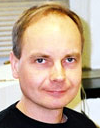Plenary speakers
 Jérôme Leroux, Bordeaux, France
Jérôme Leroux, Bordeaux, France
Ideal Decompositions for Vector Addition SystemsVector addition systems, or equivalently Petri nets, are one of the most popular formal models for the representation and the analysis of parallel processes. Many problems for vector addition systems are known to be decidable thanks to the theory of well-structured transition systems. Indeed, vector addition systems with configurations equipped with the classical point-wise ordering are well-structured transition systems. Based on this observation, problems like coverability or termination can be proven decidable. However, the theory of well-structured transition systems does not explain the decidability of the reachability problem. In this presentation, we show that runs of vector addition systems can also be equipped with a well quasi-order. This observation provides a unified understanding of the data structures involved in solving many problems for vector addition systems, including the central reachability problem. Carsten Lutz, Bremen, Germany
Carsten Lutz, Bremen, Germany
Complexity and Expressive Power of Ontology-Mediated QueriesData sets that have been collected from multiple sources or extracted from the web or often highly incomplete and heterogeneous, which makes them hard to process and query. One way to address this challenge is to use ontologies, which provide a way to assign a semantics to the data, to enrich it with domain knowledge, and to provide an enriched and uniform vocabulary for querying. The combination of a traditional database query with an ontology is called an ontology-mediated query (OMQ). The aim of this talk is to survey fundamental properties of OMQs such as their complexity, expressive power, descriptive strength, and rewritability into traditional query languages such as SQL and Datalog. A central observation is that there is a close and fruitful connection between OMQs and constraint satisfaction problems (CSPs) as well as related fragments of monadic NP, which puts OMQs into a more general perspective and gives raise to a number of interesting results. Virginia Vassilevska Williams, Stanford, USA
Virginia Vassilevska Williams, Stanford, USA
Fine-Grained Algorithms and ComplexityA central goal of algorithmic research is to determine how fast computational problems can be solved in the worst case. Theorems from complexity theory state that there are problems that, on inputs of size n, can be solved in $t(n)$ time but not in $t(n)^{1-\epsilon}$ time for $\epsilon>0$. The main challenge is to determine where in this hierarchy various natural and important problems lie. Throughout the years, many ingenious algorithmic techniques have been developed and applied to obtain blazingly fast algorithms for many problems. Nevertheless, for many other central problems, the best known running times are essentially those of the classical algorithms devised for them in the 1950s and 1960s. Unconditional lower bounds seem very difficult to obtain, and so practically all known time lower bounds are conditional. For years, the main tool for proving hardness of computational problems have been NP-hardness reductions, basing hardness on $P\neq NP$. However, when we care about the exact running time (as opposed to merely polynomial vs non-polynomial), NP-hardness is not applicable, especially if the problem can already be solved in polynomial time. In recent years, a new theory has been developed, based on ``fine-grained reductions'' that focus on exact running times. The goal of these reductions is as follows. Suppose problem A is solvable in $a(n)$ time and problem B in $b(n)$ time, and no $a(n)^{1-\epsilon}$ and $b(n)^{1-\epsilon}$ algorithms are known for A and B respectively, for any $\epsilon>0$. Then if A is fine-grained reducible to problem B (for $a(n)$ and $b(n)$), then a $b(n)^{1-\epsilon}$ time algorithm for B (for any $\epsilon>0$) implies an $a(n)^{1-\epsilon'}$ algorithm for A (for some $\epsilon'>0$). Now, mimicking NP-hardness, the approach is to (1) select a key problem X that is conjectured to require $t(n)^{1-o(1)}$ time for some $t(n)$, and (2) reduce X in a fine-grained way to many important problems. This approach has led to the discovery of many meaningful relationships between problems, and even sometimes to equivalence classes. In this talk I will give an overview of the current progress in this area of study, and will highlight some new exciting developments.
Tutorial speaker
 Jarkko Kari, Turku, Finland
Jarkko Kari, Turku, Finland
Tutorial on Cellular Automata and TilingsCellular automata (CA) are massively parallel systems where a regular grid of finite symbols is updated according to a synchronous application of the same local update rule everywhere. A closely related concept is that of Wang tiles where a local relation between neighboring symbols determines allowed combinations of symbols in the grid. In this tutorial we start with classical results on cellular automata, such as the Garden-of-Eden theorems, the Curtis-Hedlund-Lyndon -theorem and the balance property of surjective cellular automata. We then discuss Wang tiles and, in particular, the concept of aperiodicity and the undecidability of the domino problem. The domino problem is the decision problem to determine if a given Wang tile set admits any valid tilings of the grid. We relate Wang tiles to cellular automata, and establish a number of undecidability results for cellular automata.
Important dates
- Submission: Sep 18, 2015
- Rebuttal: Nov 14-16, 2015
- Notification: Dec 4, 2015
- Final version: Jan 2, 2016
- Symposium: Feb 17-20, 2016